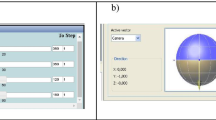Abstract
This paper reports a part of a study on the construction of mathematical meanings in terms of development of semiotic systems (gestures, speech in oral and written form, drawings) in a Vygotskian framework, where artefacts are used as tools of semiotic mediation. It describes a teaching experiment on perspective drawing at primary school (fourth to fifth grade classes), starting from a concrete experience with a Dürer’s glass to the interpretation of a new artefact. We analyse the long term process of appropriation of the mathematical model of perspective drawing (visual pyramid) through the development of gestures, speech and drawings under the teacher’s guidance.












Similar content being viewed by others
Notes
A utilization scheme (Rabardel 1995) is an active structure into which past experiences are incorporated and organized, in such a way that it becomes a reference for interpreting new data. As such, a utilization scheme is a structure with a history, which changes as it is adapted to an expanding range of situations and is contingent upon the meanings attributed to the situations by the individual.
“Thus painting will be nothing more than intersection of the visual pyramid”.
References
Alberti, L. B. (1435). De pictura (printed version 1450) (English translation of De Pictura. Retrieved August 20, 2008, retrieved from http://www.noteaccess.com/Texts/Alberti/1.htm.)
Arzarello, F. (2006). Semiosis as a multimodal process. Revista Latino Americana de Investigación en Matemática Educativa, Vol. Especial, 267–299.
Arzarello, F., Paola, D., Robutti, O., & Sabena, C. (this issue). Gestures as semiotic resources in the mathematics classroom. Educational Studies in Mathematics. doi:10.1007/s10649-008-9163-z.
Barozzi, I., & Danti, E. (1578). Le due regole della prospettiva prattica (The two rules of practical perspective) di M. Iacomo Barozzi da Vignola, Con i Commentari del Reuerendo Padre Maestro Egnatio Danti dell’Ordine de’ Predicatori Mattematico dello Studio di Bologna. Bologna.
Bartolini Bussi, M. G. (1996). Mathematical discussion and perspective drawing in primary school. Educational Studies in Mathematics, 31(1–2), 11–41. doi:10.1007/BF00143925.
Bartolini Bussi, M. G., Boni, M., Ferri, F., & Garuti, R. (1999). Early approach to theoretical thinking: Gears in primary school. Educational Studies in Mathematics, 39(1–3), 67–87. doi:10.1023/A:1003707727896.
Bartolini Bussi, M. G., & Mariotti, M. A. (2008). Semiotic mediation in the mathematics classroom: Artifacts and signs after a Vygotskian perspective. In L. English (Ed.), Handbook of international research in mathematics education (pp. 746–783, 2nd ed.). New York: Routledge.
Bartolini Bussi, M. G., Mariotti, M. A., & Ferri, F. (2005). Semiotic mediation in primary school: Dürer’s glass. In H. Hoffmann, J. Lenhard, & F. Seeger (Eds.), Activity and sign—Grounding mathematics education (Festschrift for Michael Otte) (pp. 77–90). New York: Springer.
Dapueto, C., & Parenti, L. (1999). Contributions and obstacles of contexts in the development of mathematical knowledge. Educational Studies in Mathematics, 39, 1–21. doi:10.1023/A:1003702003886.
Dürer, A. (1525). Underweysung der Messung mit Zirkel und Richtscheit. (French edition by J. Peiffer,1995). Géométrie, Paris: Ed. Seuil.
Maschietto, M., & Bartolini Bussi, M. G. (2005). Meaning construction through semiotic means: The case of the visual pyramid. In H. L. Chick, & J. L. Vincent (Eds.), Proceedings of the 29th Conference of the International Group for the Psychology of Mathematics Education: Vol. 3 (pp. 313–320). Melbourne: PME.
Maschietto, M., Bartolini Bussi, M. G., Mariotti, M.A., & Ferri, F. (2004). Visual representations in the construction of mathematical meanings. ICME 10—Topic Study Group 16: Visualisation in the teaching and learning of mathematics. Retrieved August 20, 2008, from http://www.icme-organisers.dk/tsg16/#papers.
Rabardel, P. (1995). Les hommes et les technologies—Approche cognitive des instruments contemporains. Paris: Colin.
Radford, L. (2003). Gestures, speech and the sprouting of signs: a semiotic-cultural approach to students’ types of generalization. Mathematical Thinking and Learning, 5(1), 37–70. doi:10.1207/S15327833MTL0501_02.
Radford, L. (this issue). Why do gestures matter? Sensuous cognition and the palpability of mathematical meanings. Educational Studies in Mathematics. doi:10.1007/s10649-008-9127-3.
Stetsenko, A. (1995). The psychological function of children’s drawing. A Vygotskian perspective. In C. Lange-Kuettner, & G. V. Thomas (Eds.), Drawing and looking (pp. 147–158). Hemel Hempstead: Prentice Hall/Harvester Wheatsheaf.
Vygotskij, L. S. (1974). Storia dello sviluppo delle funzioni psichiche superiori e altri scritti. Firenze: Giunti.
Vygotsky, L. S. (1978). Mind in society. The development of higher psychological processes. Cambridge, MA: Harvard University Press.
Wartofsky, M. (1979). Perception, representation, and the forms of action: Towards an historical epistemology. In M. Wartofsky (Ed.), Models, representation and the scientific understanding (pp. 188–209). Dordrecht: Reidel.
Author information
Authors and Affiliations
Corresponding author
Additional information
This paper reports a part of a study carried out together with Maria Alessandra Mariotti and Franca Ferri, within the National Project PRIN 200501972: “Meanings, conjectures, proofs: From basic research in mathematics education to curricular implications”.
Rights and permissions
About this article
Cite this article
Maschietto, M., Bartolini Bussi, M.G. Working with artefacts: gestures, drawings and speech in the construction of the mathematical meaning of the visual pyramid. Educ Stud Math 70, 143–157 (2009). https://doi.org/10.1007/s10649-008-9162-0
Received:
Accepted:
Published:
Issue Date:
DOI: https://doi.org/10.1007/s10649-008-9162-0




